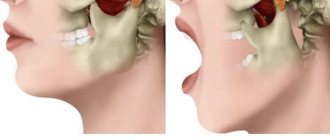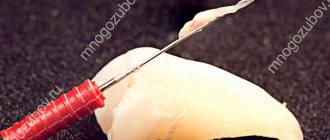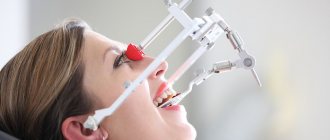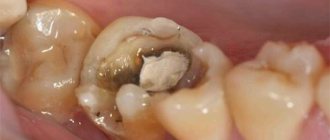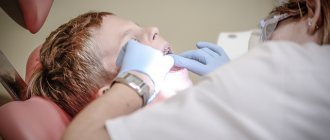The lower jaw of a person is mobile, which allows him to talk, chew food and more. Together with the temporal bones, it forms the mandibular joint. If everything is fine with him, the person does not experience difficulties with chewing, speaking, or eating. Problems begin when the jaw becomes jammed. Thus, a dislocated jaw not only leads to a person’s inability to speak and chew food, but also causes severe pain around the affected joint. The answer to the question “what to do in such a situation” is that it will have to be adjusted, and only by a specialized specialist.
Description and symptoms of jaw joint dislocation
Discomfort in the jaw area most often occurs due to problems with the temporomandibular joint. It is formed by the head of the lower part of the jaw and the tubercle of the temporal bone, which, together with the articular disc, are part of the capsule. The work of this joint is very complex and is associated with a whole set of muscles. If something goes wrong, not only the joint itself suffers, but also the muscles of the neck, head, and cranial nerves, resulting in chronic pain, most often from one – the problematic – part of the head.
Symptoms of TMJ dysfunction are varied - pain in the ears, head, and neck.
Why is it impossible to open your mouth wide or completely?
There are no nerve endings in the joint, so it does not hurt, but discomfort may occur. Toothache also often develops, and there is a feeling of squeezing of the eyes. Another key indicator of TMJ problems is jaw locking. The patient cannot completely close or open his mouth, and in order to make the desired jaw movement, he is forced to look for a position in which the joint functions normally. When moving the jaw left and right, clicking sounds are possible. Secondary manifestations of TMJ pathologies:
- irritability;
- sleep problems;
- general malaise;
- noise in ears;
- Bad mood;
- snore;
- xerostomia;
- muscle pain;
- twitching of the eye muscles;
- drop in visual acuity;
- paresthesia.
According to medical observations, the ANS (temporomandibular joint) plays the role of the center of balance of the whole organism.
To the dentist!
The cause of discomfort may also be due to incorrect position of the teeth. In this case, you will need the help of a maxillofacial dentist who will supply temporary or permanent splints and dentures that correct the incorrect position of the jaw.
Article on the topic
A tooth for a tooth: what happens if the jaws don’t close?
A rehabilitation doctor can help if the pain is caused by increased tone or tension of the masticatory muscles, limited mobility of the lower jaw, incoordination of contractions of the masticatory muscles, excessive mobility of the head of the lower jaw (sometimes this causes “clicking” in the temporomandibular joint).
Pain and clicking disappear after normalization of the function of the masticatory muscles and joint, except in cases where arthrosis deformans and inflammation in the joint are diagnosed. Then treatment should begin with following the recommendations of a rheumatologist and orthopedist.
Causes
Dislocation of the lower jaw is a common pathology that occurs due to the ease of injury and the accident factor. It is not necessary to get injured (fight, fall), yawn widely or try to bite off a huge piece of something - sometimes it is enough just to open your mouth unsuccessfully. Other factors that can lead to the development of pathology are loud screams, yawning, inaccurate eating, difficult tooth extraction, malocclusion, bruxism with increased tooth wear.
Regular consumption of very hard foods and a love of opening different packages with your teeth increases the chances of TMJ subluxation.
According to another medical theory, the causes of TMJ dysfunction are myogenic - that is, they lie in problems with the facial muscles. We are talking about their overload during chewing, tonic spasms, and increased speech activity. Problems with the central nervous system also have an impact - constant stress and exhaustion negatively affect facial muscles and joint mobility.
Some people have a congenital predisposition to TMJ dysfunction - for example, if the sizes of the articular fossa and heads do not initially match, jaw asymmetry occurs. And according to statistics, women often turn to doctors with jaw dislocations - the fact is that the male ligamentous apparatus is more developed and stronger, and therefore can withstand significant loads. In men, problems in the TMJ often develop against the background of rheumatism, polyarthritis, and gout.
Why is there a problem?
The “culprit” for the jammed jaw is the TMJ. This formation, from an anatomical point of view, is problematic - with significant mobility, its individual elements (pits, processes, articular cavity) do not correspond to each other in size. It is this structure of the joint that ensures the ability to move the lower jaw to the right and left to carry out full chewing movements.
Important! According to medical statistics, at least 70% of the world's population experience malfunctions of the TMJ.
The reasons that the jaw does not open completely can be varied:
- malocclusion;
- dental treatment performed (for example, wisdom tooth removal);
- prosthetics;
- bruxism and the accompanying rapid wear of tooth enamel;
- the jaw also jams after injuries to the face, neck, or when eating hard, rough food;
- Often the problem becomes a consequence of an anomaly in the structure of the dentition.
Specific anatomy increases the risk of arthrosis and arthritis. dislocations, dysfunction of the temporomandibular joint
There is also a myogenic theory of TMJ dysfunction - its supporters explain the inability to open the mouth wide with spasms of the facial muscles. Thus, the causes of the anomaly are hypertonicity of the masticatory and facial muscles, increased speech load (in people of public professions). Some doctors associate malfunctions in the TMJ with psychogenic factors - disturbances in the functioning of the central nervous system. Emotional stress caused by frequent stress also affects the functions of this joint.
TMJ dysfunction also has a hereditary basis, if from birth the sizes of the heads and articular fossae do not match. It happens that the cause of a jammed jaw is a dislocation of the TMJ. You can get such an injury when chewing hard food or opening your mouth wide while yawning, or using a mouth opener in the dental office.
Dislocation of the TMJ can be caused by:
- injuries to the jaw and teeth;
- habit of opening bottles with teeth;
- shallow fossa, weak ligaments and other anatomical features of the joint.
Important! TMJ dislocations can be unilateral or bilateral.
Treatment
Treatment of jaw dislocation should be carried out only by a doctor; he chooses the method taking into account the diagnostic results. The fact is that, despite similar symptoms, each type of injury has its own characteristics and methods of elimination. The main method of therapy is reduction of the jaw joint, which can be carried out using the Hippocratic, Blechman-Gershuny, or Popescu Method. The jaw is pressed with your hands (gently) and set in the required position. If everything is done correctly, it will need to be secured with a bandage, which will help avoid recurrence of loss.
Never try to straighten your jaw yourself. Only a specialist can carry out this procedure correctly.
Old dislocations can often only be removed surgically; after surgery you need to wear special devices. Dentures can also be used for habitual dislocation of the lower jaw. They can be removable or permanent and are used to limit the degree of mobility of the joints of the lower jaw. The duration of wearing is determined by the doctor - it depends on the recovery time of the sprained ligaments.
You cannot adjust the jaw at home yourself, as this can only worsen the patient’s condition.
What can you do at home if your jaw is stuck?
Nonsteroidal anti-inflammatory drugs reduce pain and stop the inflammatory process. They are always prescribed for jaw dislocation, internally and externally; the standard treatment period is 2 weeks; if necessary, it can be extended. To speed up recovery after reduction or surgery, techniques such as ultrasound, electrophoresis, and laser therapy can be used. After completion of treatment, discomfort in the injured area rarely remains; it is eliminated using special ointments.
Take first aid measures to alleviate a person’s condition when their jaw is jammed:
- limit jaw mobility by securing it with a bandage in the least painful position;
- give me a painkiller.
The prognosis for treatment for dislocations is positive, but no one is immune from relapses. To minimize the risks of their development, wear special dentures to limit mouth opening, correct teeth, especially if a tooth is dislocated, which could cause displacement of the joint, promptly treat and prosthetize chewing teeth, and do myogymnastics (it strengthens the chewing muscles). In the future, to avoid dislocations and injuries to the jaw, monitor the amplitude of mouth opening.
Prevention of joint inflammation
Gymnastics for training facial muscles
The jaw can become blocked and pinched in different situations: open your mouth wide enough or yawn. But the risk of injury is increased by hidden infections, gout, osteoporosis and polyarthritis. The following measures are recommended as prevention:
- giving up the habit of gnawing crackers, nuts, pencils;
- eat soft and liquid foods;
- monitor the condition of the dentures, visit the dentist regularly;
- daily training of the masticatory muscles using myogymnastics.
If your jaw is jammed on one or both sides, it is better to give up trying to straighten it yourself. Otherwise, there is a risk of relapse and osteomyelitis due to latent infections. It is necessary to strictly adhere to the specialist’s recommendations and take preventive measures to restore joint mobility.
Possible complications
In the absence of proper treatment, the primary dislocation of the jaw turns into an old one, and if you correct it yourself incorrectly (we strongly advise you not to do this), over time, with a high degree of probability, the need for surgical intervention will arise. This material will tell you what to do if toothache radiates to your temple.
The main complications of TMJ dislocation:
- bruxism;
Bruxism or teeth grinding leads to excessive tooth wear or complete loss.
- erasing enamel;
- pain when chewing;
- clicks;
- arthrosis
A medical consultation is required, since a jammed jaw may indicate not only a dislocation of the joint, but also a fracture, osteomyelitis of the jaw, arteritis of the facial artery, and dysfunctional changes in the jaw apparatus. And the sooner they are detected, the more positive the treatment prognosis will be. Find out why you grind your teeth in your sleep here.
If your jaw is jammed, your doctor will first try conservative methods, and if they don’t help, he will recommend other options.
Causes
There are several groups of etiological factors in the development of pain.
Dental problems
So, if it is painful for a person to open his mouth, this may indicate damage to the integrity of the bone tissue of the lower jaw. Fights, sports, accidents - these are situations in which you can get injured. The list of the most common ones includes:
- dislocations;
- bruises;
- fractures.
It is not difficult to dislocate the mandibular joint - all you need to do is make a sudden, inaccurate movement (for example, open your mouth too wide). When a dislocation occurs, the head of the TMJ “leaves” its place in the articular fossa - as a result, the “victim” of the injury experiences severe pain in the jaw, the mouth does not open completely, the facial muscles become numb, local swelling occurs, and speech becomes slurred.
Bruises - soft tissue injuries - lead not only to jaw pain, but also to the appearance of hematomas, swelling, hyperemia of the affected area, asymmetry of the facial muscles
Important! A dislocation can be determined visually because the jaw is shifted to the right or left side and the face is asymmetrical.
Pain in the jaw joint can be caused not only by bone damage, but also by soft tissue bruises. So, in the place where the main blow occurred, a hematoma and swelling appear, the patient cannot open his mouth, and discomfort occurs when chewing. It is noteworthy that, as a rule, the consequences of a bruise go away on their own - after 4-5 days, the unpleasant sensations disappear.
The fact that the mouth does not open, pain appears in the jaw on the left or right, a ache is felt in the teeth, the face becomes asymmetrical - all this may indicate a fracture. Treating such an injury is not easy - restoring damaged bone tissue requires time and effort.
Discomfort when opening the mouth also occurs with many dental problems. First of all, we are talking about inflammation that affects the soft tissues of the oral cavity. The causative agents of inflammation can be bacteria, viruses and fungi. Often the course of a particular dental disease is accompanied by the appearance of purulent formations.
Thus, the most common pathologies of a purulent nature are:
What to do if your jaw is stuck
- Boils. An abscess is formed when an infection enters a hair follicle (usually through a wound on the skin). Gradually, local inflammation spreads to deeper soft tissues, they fester, and pain may occur in the jaw due to compression of the nerve endings.
- Osteomyelitis. A complication of periodontitis, purulent dental cysts, develops when bacteria from the oral cavity enter directly into the bone tissue during injuries (burns). The list of classic signs of osteomyelitis includes: pain in the jaw when you open your mouth wide, hyperthermia, fever, swelling of the face, enlarged submandibular lymph nodes, headaches and toothaches.
- Cellulitis, abscesses. Inflammatory processes, the course of which is accompanied by the formation of a large amount of pus, swelling, sharp pain when chewing, opening the mouth and any other functional load on the jaw. With an abscess, a closed inflammation forms, with phlegmon, the focus is blurred. The main complication of such ulcers is the high risk of self-resolution with subsequent blood poisoning.
Important! General symptoms such as elevated body temperature, difficulty chewing and swallowing, and jaw pain should alert a person and prompt immediate medical attention.
TMJ dysfunction is a common cause of pain and jaw crunching when opening the mouth.
When the dentist has poorly secured the bite correction structure or performed poor-quality prosthetics, patients may also experience discomfort in the upper and lower jaw. The classic “provocateurs” of pain are braces - after their installation, most people experience discomfort not only when chewing, moving facial muscles, during a conversation, but even in a calm state.
By the way, such discomfort is a completely normal phenomenon, which, as a rule, disappears after the bone and soft tissues adapt to the constant wearing of the bite-correcting structure. Other causes of jaw pain of odontogenic origin:
- caries;
- pulpitis with damage to the nerve of the tooth;
- periodontitis (inflammation of periodontal tissues);
- dental injuries (chips, neck fractures);
- gingivitis (inflammation of the gums);
- alveolitis (an inflammatory process affecting the alveolar process that develops after tooth extraction).
If the mouth does not open completely, there is pain when chewing, the face is swollen - all this may indicate the appearance of benign or malignant neoplasms. In the early stages, such pathological processes are “silent”, so patients seek help from a doctor only when the abnormal process is quite advanced.
The list of the most common benign formations that cause pain and discomfort in the jaw area includes: osteomas, adamantiomas, osteoblatoclastomas. Dangerous malignant pathologies include: sarcomas (affect connective tissue), osteogenic origin - affecting bones, various types of cancer (localized in the epithelium).
Fluxes, abscesses, phlegmons and other purulent-inflammatory formations are also included in the list of “provocateurs” of jaw pain
It is noteworthy that malignant neoplasms are most often localized on the lower jaw (on the left or right side). Timely diagnosis of such pathologies allows you to take the necessary therapeutic measures and avoid the spread of metastases to other organs.
Arthritis, arthrosis of the TMJ are diseases that lead to pain in the lower jaw when opening the mouth (or while chewing), as well as in a calm state. In this case, the discomfort is “tied” to the lesion itself and is localized closer to the auricle. The pain can radiate to the neck, upper jaw, or eye sockets.
X-ray is a diagnostic measure that allows you to timely detect inflammation (signs of dysfunction) of the TMJ on the right or left and select the appropriate treatment. If nothing is done, arthrosis and arthritis in this area can lead to complete immobilization of the jaw (a person simply will not be able to open his mouth).
Non-dental diseases
Neuralgia and bruxism are the most common causes of jaw pain. In the first case, the trigeminal, superior laryngeal, and glossopharyngeal nerves are affected (pinched). The course of the disease is accompanied by increased pain when chewing and swallowing food, profuse salivation, pain when yawning, and movement of facial muscles.
Involuntary closing of the jaw and grinding of teeth (bruxism) cause frequent stress and other forms of nervous disorders; most often, people who have an abnormal bite suffer from this problem. Relaxing exercises and massage help to cope with the unpleasant symptoms of bruxism, which include pain in the jaw, and special day and night splints are designed to protect teeth from mechanical damage.
Various types of migraine pain radiate to the ear, eye sockets, upper and lower jaw
Important! Myocardial infarction also causes severe pain in the jaw.
The list of other signs of this serious pathology leading to necrosis of the heart muscle includes acute squeezing pain in the left side of the chest, which lasts for 15–20 minutes and does not go away even after taking painkillers, as well as shortness of breath and increased sweating.
An attack of angina (spasm of the coronary arteries) is another “provocateur” of discomfort in the jaw area. The appearance of symptoms indicating a cardiac disorder is a reason to seek medical help.
Other factors
Why does my jaw still hurt?
- Tetanus. Additional signs: convulsions, difficulty swallowing (dysphagia). The patient requires immediate medical attention (administration of antitetanus serum).
- Carotidynia (a type of migraine). Symptoms: attacks of pain, the duration of which varies from a few minutes to 2-3 hours. Unpleasant sensations are localized in the lower jaw and radiate to the ears and eye sockets.
- Red ear syndrome. Accompanies the course of spondylosis and damage to the pituitary gland.
Jaw pain in children often occurs due to mumps, as well as a violation of calcium-phosphorus metabolism in the body.
